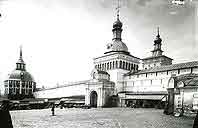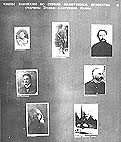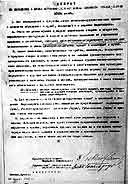G.A. M└K└R╬VS╩└YA
ôOn the Problem of Restoration of the Architectural Ensemble
of the Trinity-St. Sergius Lavra between the 1920s and1990s (page 1)
 The problem of preservation and restoration of architectural monuments is very important. It is even more complicated, when it concerns such a unique complex as the architectural ensemble of the Trinity-St. Sergius Lavra in Sergiev Posad. In this article we shall dwell only on the most essential stages of its restoration in the cause of 70 years without comment on the hot discussions around different restoration projects and reasons for them, as it could be a subject of a separate serious work. In these cases, we shall be limited only to references to the corresponding literature.
The problem of preservation and restoration of architectural monuments is very important. It is even more complicated, when it concerns such a unique complex as the architectural ensemble of the Trinity-St. Sergius Lavra in Sergiev Posad. In this article we shall dwell only on the most essential stages of its restoration in the cause of 70 years without comment on the hot discussions around different restoration projects and reasons for them, as it could be a subject of a separate serious work. In these cases, we shall be limited only to references to the corresponding literature.
 The monuments of the Lavra were nationalized by the decision of the Council of the Peopleĺs Commissars on November, 1st, 1918. In a year the Monastery was closed, the monks moved to the Chernigov and Gethsemane Sketes. For the Lavra protection they formed the Commission on Protection of History and Art Monuments of the Trinity-St. Sergius Lavra. The main tasks of the Commission were registration, investigation and preservation of the monuments; restoration of architecture, painting and embroidery. A part from the members of the Commission, famous experts were involved in those works. The archive of the Sergiev Posad Museum kept the report of architect N. Zhukov on the state of the Duck and Water towers, the resolution of I.V. Rylsky and the former Lavra architect A.A. Latkov on the examination of the Trinity Cathedral, the act of the inspection of the Transfiguration Church in the Savior- Bethany Monastery by architect Feoktistov and other documents.
The monuments of the Lavra were nationalized by the decision of the Council of the Peopleĺs Commissars on November, 1st, 1918. In a year the Monastery was closed, the monks moved to the Chernigov and Gethsemane Sketes. For the Lavra protection they formed the Commission on Protection of History and Art Monuments of the Trinity-St. Sergius Lavra. The main tasks of the Commission were registration, investigation and preservation of the monuments; restoration of architecture, painting and embroidery. A part from the members of the Commission, famous experts were involved in those works. The archive of the Sergiev Posad Museum kept the report of architect N. Zhukov on the state of the Duck and Water towers, the resolution of I.V. Rylsky and the former Lavra architect A.A. Latkov on the examination of the Trinity Cathedral, the act of the inspection of the Transfiguration Church in the Savior- Bethany Monastery by architect Feoktistov and other documents.
 Architecture was paid special attention to. The complex of the Lavra monuments, created in the cause of nearly six centuries, with its composite integrity and majestic beauty was always recognized by the researchers as one of the best creations of Russian architecture but, in 1918, it was, perhaps, for the first time that the accent was laid on the magnificent artistic harmony, or on the ensemble, which was the highest achievement of such a complex art as architecture. In view of the exceptional historical and artistic value of the architectural ensemble and the collections revealed by the Commission, the Trinity-St. Sergius Lavra was put under the state protection and was subordinated to the Department on the Museums Affairs and Protection of History and Art Monuments of the Peopleĺs Commissariat on Education. On April 20, 1920, V.I. Lenin signed the Decree of the Soviet of the Peopleĺs Commissars "On Turning of History and Art Monuments of the Trinity-St. Sergius Lavra into a Museum". That day became the date of the Museum foundation.
Architecture was paid special attention to. The complex of the Lavra monuments, created in the cause of nearly six centuries, with its composite integrity and majestic beauty was always recognized by the researchers as one of the best creations of Russian architecture but, in 1918, it was, perhaps, for the first time that the accent was laid on the magnificent artistic harmony, or on the ensemble, which was the highest achievement of such a complex art as architecture. In view of the exceptional historical and artistic value of the architectural ensemble and the collections revealed by the Commission, the Trinity-St. Sergius Lavra was put under the state protection and was subordinated to the Department on the Museums Affairs and Protection of History and Art Monuments of the Peopleĺs Commissariat on Education. On April 20, 1920, V.I. Lenin signed the Decree of the Soviet of the Peopleĺs Commissars "On Turning of History and Art Monuments of the Trinity-St. Sergius Lavra into a Museum". That day became the date of the Museum foundation.
From April till June, 1920, the interdepartmental commission defined the art and historical significance of the Lavra buildings and constructions. "The Rules of the Protection of Art and History Collections of the Sergiev Museum" regulated the management of the buildings and treasures. The main tasks were investigation and wide display of the cultural heritage. The Architectural Department was formed. It was absolutely clear, that the main task was to save everything that had been ruined by the time and human neglect. The restoration of the ancient Lavra appearance was impossible at that extraordinary hard period, therefore the restoration, conceived by the Museum, was carried out gradually, and the process lasted for several decades.
|


